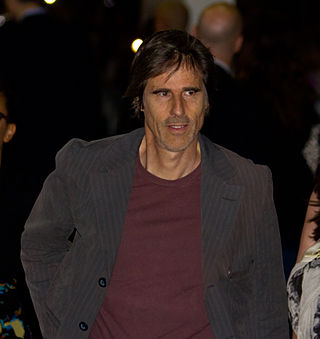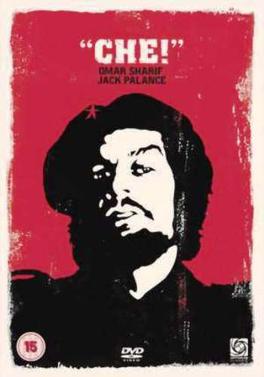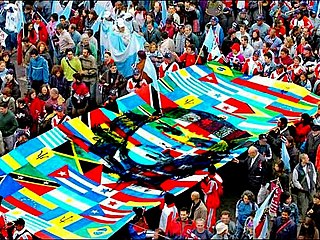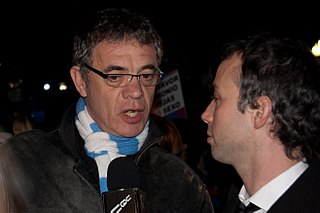
Diego Dionisio Luna Alexander is a Mexican actor, director, and producer, best known for his portrayal of Cassian Andor in Rogue One: A Star Wars Story and the Disney+ series Andor, for which he was nominated for a Golden Globe Award for Best Actor - Television Series Drama.

Gael García Bernal is a Mexican actor and filmmaker. He is known for his performances in the films Amores perros (2000), Y tu mamá también (2001), Bad Education (2004), The Motorcycle Diaries (2004), Babel (2006), Coco (2017), and Old (2021), for his role as Rodrigo de Souza in the television series Mozart in the Jungle (2014–2018), and for starring in the Disney+ special Werewolf by Night (2022).

Alberto Granado Jiménez was an Argentine–Cuban biochemist, doctor, writer, and scientist. He was also the youthful friend and traveling companion of Che Guevara during their 1952 motorcycle tour in Latin America. Granado later founded the University of Santiago de Cuba School of Medicine. He authored the memoir Traveling with Che Guevara: The Making of a Revolutionary, which served as a reference for the 2004 film The Motorcycle Diaries, in which he was played by Rodrigo de la Serna. An elderly Alberto Granado makes a short appearance at the end of the film.

The Motorcycle Diaries is a posthumously published memoir of the Marxist revolutionary Ernesto "Che" Guevara. It traces his early travels, as a 23-year-old medical student, with his friend Alberto Granado, a 29-year-old biochemist. Leaving Buenos Aires, Argentina, in January 1952 on the back of a sputtering single cylinder 1939 Norton 500cc dubbed La Poderosa, they desired to explore the South America they only knew from books. During the formative odyssey Guevara is transformed by witnessing the social injustices of exploited mine workers, persecuted communists, ostracized lepers, and the tattered descendants of a once-great Inca civilization. By journey's end, they had travelled for a "symbolic nine months" by motorcycle, steamship, raft, horse, bus, and hitchhiking, covering more than 8,000 kilometres across places such as the Andes, the Atacama Desert, and the Amazon River Basin.

Walter Moreira Salles Júnior is a Brazilian filmmaker, most known for his Golden Bear-winning film Central Station.

José Rivera is a playwright and the first Puerto Rican screenwriter to be nominated for an Academy Award for the movie, The Motorcycle Diaries.

Lionel Rodrigo de la Serna is an Argentine actor. He is known for playing Alberto Granado in the 2004 biopic The Motorcycle Diaries and Palermo in the Netflix series Money Heist.

Fidel, titled onscreen as ¡Fidel!, is a 2002 American biographical drama television film directed by David Attwood about the Cuban Revolution and political career of Fidel Castro, played by Víctor Huggo Martin. Gael García Bernal, Patricia Velásquez, Cecilia Suárez, Manuel Sevilla, and Maurice Compte also star. The screenplay by Stephen Tolkin is based on two biographies of Castro: Guerilla Prince: The Untold Story of Fidel Castro (1991) by Georgie Anne Geyer, and Fidel Castro (1993) by Robert E. Quirk. The film aired on Showtime in two parts, on January 27 and 28, 2002. The total duration of the film is 200 minutes, but the video version is shorter. García Bernal would reprise his role as Che Guevara in the 2004 feature film The Motorcycle Diaries.

Che! is a 1969 American biographical film directed by Richard Fleischer and starring Omar Sharif as Marxist revolutionary Ernesto "Che" Guevara. It follows Guevara from when he first landed in Cuba in 1956 to his death in Bolivia in 1967, although the film does not portray the formative pre-Cuban revolution sections of Che's life as described in the autobiographical book The Motorcycle Diaries (1993).
San Pablo de Loreto is a village, and the location of a leper colony in Peru. The village is located near Iquitos. The colony was constructed in 1925. In 1941, it became an agricultural colony in which the patients had to work the fields. In 1952, Che Guevara and Alberto Granado worked at the colony. The colony was home to around 600 people at the time. By 1957, the number of patients had increased to about 780. The colony was closed for admission from 1967 onwards, and a 1968 report by Dr Masayoshi Itoh described that 87% of the patients were in need of surgical treatment. The leprosium has since then closed, and the patients have been transferred to Iquitos.

Aleida Guevara March is a Cuban physician who is the eldest of four children born to Ernesto "Che" Guevara and his second wife, Aleida March.

Appearances of Argentine Marxist revolutionary Che Guevara (1928–1967) in popular culture are common throughout the world. Although during his lifetime he was a highly politicized and controversial figure, in death his stylized image has been transformed into a worldwide emblem for an array of causes, representing a complex mesh of sometimes conflicting narratives. Che Guevara's image is viewed as everything from an inspirational icon of revolution, to a retro and vintage logo. Most commonly he is represented by a facial caricature originally by Irish artist Jim Fitzpatrick and based on Alberto Korda's famous 1960 photograph titled Guerrillero Heroico. The evocative simulacra abbreviation of the photographic portrait allowed for easy reproduction and instant recognizability across various uses. For many around the world, Che has become a generic symbol of the underdog, the idealist, the iconoclast, or the martyr. He has become, as author Michael Casey notes in Che's Afterlife: The Legacy of an Image, "the quintessential postmodern icon signifying anything to anyone and everything to everyone."

Ernesto "Che" Guevara was an Argentine Marxist revolutionary, physician, author, guerrilla leader, diplomat, and military theorist. A major figure of the Cuban Revolution, his stylized visage has become a ubiquitous countercultural symbol of rebellion and global insignia in popular culture.

The legacy of Argentine Marxist revolutionary Che Guevara is constantly evolving in the collective imagination. As a symbol of counterculture worldwide, Guevara is one of the most recognizable and influential revolutionary figures of the twentieth century. However, during his life, and even more since his death, Che has elicited controversy and wildly divergent opinions on his personal character and actions. He has been both revered and reviled, being characterized as everything from a heroic defender of the poor, to a cold-hearted executioner.
Ernesto "Che" Guevara, was an Argentine Marxist revolutionary, politician, author, intellectual, physician, military theorist, and guerrilla leader. His life, legacy, and ideas have attracted a great deal of interest from historians, artists, film makers, musicians, and biographers. In reference to the abundance of material, Nobel Prize–winning author Gabriel García Márquez has declared that "it would take a thousand years and a million pages to write Che's biography."

Che Rise and Fall is a documentary film created by Eduardo Montes-Bradley. The film was entirely shot in Cuba at the time Che Guevara’s remains was airlifted from Bolivia to Santa Clara the final resting place. The documentary features the testimonies of Guevara’s comrades-in-arms in Sierra Maestra, Congo and Bolivia, also with Alberto Granado with whom Guevara rode a motorcycle from Argentina on a trip that will end 16 years later in the jungles of Bolivia, an experience that was brought to the big screen on The Motorcycle Diaries. Che Rise and Fall begins with an account of Guevara's death in Bolivia in 1967 and fittingly ends with footage of the return of his remains for interment in a monument in Santa Clara's Revolution Square some 30 years later.

Guerrillero Heroico is an iconic photograph of Marxist revolutionary Che Guevara taken by Alberto Korda. It was captured on March 5, 1960, in Havana, Cuba, at a memorial service for victims of the La Coubre explosion. By the end of the 1960s, the image, in conjunction with Guevara's subsequent actions and eventual execution, helped solidify the leader as a cultural icon. Korda has said that at the moment he shot the picture, he was drawn to Guevara's facial expression, which showed "absolute implacability" as well as anger and pain. Years later, Korda would say that the photograph showed Che's firm and stoical character. Guevara was 31 years old at the time the photograph was taken.

Jean Pierre Noher is a French-born Argentine actor.

Gianni Minà was an Italian journalist, writer, magazine editor, and television host. He collaborated with both Italian and International newspapers and magazines; produced hundreds of reports for RAI ; conceived and hosted television programs, as well as produced successful documentary films on the lives of Che Guevara, Muhammad Ali, Fidel Castro, Rigoberta Menchú, Silvia Baraldini, Subcomandante Marcos and Diego Maradona.
Chevolution is a 2008 documentary film which examines the history and legacy of the photo Guerrillero Heroico taken by famous Cuban photographer Alberto Díaz Gutiérrez. This image has thrived for the decades since Che Guevara's death and has evolved into an iconic image, which represents a multitude of ideals. The documentary explores the story of how the photo came to be, its adoption of multiple interpretations and meanings, as well as the commercialization of the image of Ernesto "Che" Guevara.

















